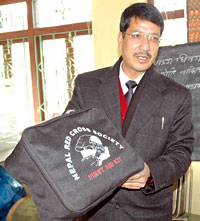 "I was trying to stop the ground from moving by pushing on the earth but it didn't work," remembers Asha Ratna Dhakwa, 85, of the 1934 earthquake that devastated Kathmandu killing at least 10,000 people.
"I was trying to stop the ground from moving by pushing on the earth but it didn't work," remembers Asha Ratna Dhakwa, 85, of the 1934 earthquake that devastated Kathmandu killing at least 10,000 people.
Walking in Nag Bahal in Patan you understand Dhakwa's predicament. Narrow dark gallis with houses crowded together on both sides lead to chowks surrounded by old and new buildings, many at least four storeys tall. The bahals lead to even more narrow alleys. These serpentine streets are one reason municipal officials singled out Ward 16 for earthquake preparedness.
"We could have gone anywhere but we chose places from where the people are enthusiastic and want to take responsibility," explains Amod Mani Dixit of the National Society for Earthquake Technology (NSET).
With the Nepal Red Cross Society and Kathmandu Valley Earthquake Preparedness Initiative, NSET helps Ward 16 with earthquake preparedness. It includes raising awareness by distributing brochures door-to-door and community mobilisation. Around 60 people have been trained on rescue, relief and primary treatment. Of those, about 20 were selected for further training and to pass on that knowledge to other residents of their toles.
The Red Cross helped install first aid containers in four strategic spots in Ward 16. They contain stretchers, medical supplies and rescue equipment such as shovels, stoves, helmets, jackets, boots, torches and lanterns. "We also have 300 sets of blankets and tents ready for those who need it when disaster strikes," says Dilip Joshi of Nepal Red Cross Society.
In addition, the awareness programs that are held regularly emphasise what people should do before a major disaster strikes. "Our aim is to save as many lives as possible and that can be achieved only through people who are trained in relief and rescue," adds Joshi.
 Across the river in Kathmandu, Ward 17 residents aren't counting on the government to deliver relief when the Big One strikes. Instead, they have set up a program that mixes awareness, training, survival skills and helping neighbours.
Across the river in Kathmandu, Ward 17 residents aren't counting on the government to deliver relief when the Big One strikes. Instead, they have set up a program that mixes awareness, training, survival skills and helping neighbours.
"Should an earthquake take place, the government will take more than a week to respond but we are prepared to cover that void with our own volunteers," says Bibhuti Singh, coordinator of Ward 17 Disaster Management Committee. "We are not just trying to make the community safe but also preparing ourselves for rapid reaction and self reliance for a week," adds Singh.
Not all wards in Patan and Kathmandu have been as enthusastic. Some just couldn't be bothered, others set up committes but didn't have the commitment to follow through. But local organisations, such as the Rotary, youth clubs, schools, the municipality and ward police of ward 17 have also risen to the occasion. They meet regularly and over three years have trained 200 colunteers. "We need at least 200 volunteers for every 20,000 populations to make up for volunteers who perish in a future quake," says Singh.
Though most of Ward 17's buildings are liable to collapse when the quake hits, residents have been trained to move to safe spots: near a column, under a door or in corners, depending on the building's structure. People here have a strong sense of community, not only are they well on the way to making their own ward secure, they are also helping neighbouring Wards 29 and 30 prepare as well.
"We have made Wards 17, 29 and 30 secure and I guess we could handle two more but there are 110 wards and over two million people in Kathmandu, what about them?" asks Singh shaking his head.
But at least Ward 16 in Patan and Ward 17 in Kathmandu have shown the way for the others to follow. One day soon, we will be glad we are prepared.
Picture Caption: SHAKE IT ALL ABOUT: Patan residents watch what happens to a model of a house during a temblor (top) and Dilip Joshi of the Nepal Red Cross shows a quake safety kit. (PICS: KIRAN PANDAY)


